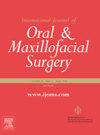Extended temporomandibular joint prostheses: a retrospective analysis of feasibility, outcomes, and complications
IF 2.2
3区 医学
Q2 DENTISTRY, ORAL SURGERY & MEDICINE
International journal of oral and maxillofacial surgery
Pub Date : 2024-10-31
DOI:10.1016/j.ijom.2024.10.007
引用次数: 0
Abstract
Prostheses for extended total temporomandibular joint replacement (eTJR) include modifications to the traditional alloplastic fossa–condyle joint that extend to adjacent bone defects. The aim of this retrospective study was to assess the feasibility, postoperative complications, and functional and aesthetic outcomes after eTJR. Patients aged ≥18 years undergoing eTJR between 2013 and 2022 were included. Data recorded were age, sex, comorbidities, indication for eTJR, prosthesis brand, classification, concomitant surgical procedures, postoperative complications, maximum inter-incisal opening (MIO), pain, quality of life (QoL), and aesthetic outcome. Twenty-five patients (mean age 40 years), with a total of 30 joint prostheses, were included. Over a median follow-up of 42 months, there was a significant improvement in MIO in patients with reduced mouth opening at baseline (P = 0.003), as well as in pain (P = 0.007) and QoL (P = 0.004). Both patients and surgeons judged facial appearance as improved or unchanged in 88% of cases. Postoperative complications included permanent trigeminal nerve hypoesthesia (44%), permanent facial nerve dysfunction (35%), infection (8%), salivary leak (4%), and lingual nerve impairment (4%). The findings suggest that eTJR is a safe and effective treatment for temporomandibular joint deficits extending to adjacent structures, yielding satisfactory functional and aesthetic outcomes.
加长型颞下颌关节假体:对可行性、效果和并发症的回顾性分析。
扩展全颞下颌关节置换术(eTJR)的假体包括对传统的异体窝-髁状关节的改良,扩展到邻近的骨缺损。这项回顾性研究旨在评估eTJR的可行性、术后并发症以及功能和美学效果。研究纳入了2013年至2022年间接受eTJR手术的年龄≥18岁的患者。记录的数据包括年龄、性别、合并症、eTJR的适应症、假体品牌、分类、伴随的外科手术、术后并发症、最大椎间隙(MIO)、疼痛、生活质量(QoL)和美学效果。研究共纳入了 25 名患者(平均年龄 40 岁),共使用了 30 个关节假体。在中位 42 个月的随访中,基线张口度降低的患者的 MIO(P = 0.003)、疼痛(P = 0.007)和 QoL(P = 0.004)均有显著改善。在 88% 的病例中,患者和外科医生都认为面部外观得到了改善或保持不变。术后并发症包括永久性三叉神经麻痹(44%)、永久性面神经功能障碍(35%)、感染(8%)、唾液渗漏(4%)和舌神经损伤(4%)。研究结果表明,eTJR 是一种安全有效的治疗方法,可用于治疗颞下颌关节功能障碍扩展到邻近结构的情况,并能产生令人满意的功能和美观效果。
本文章由计算机程序翻译,如有差异,请以英文原文为准。
求助全文
约1分钟内获得全文
求助全文
来源期刊
CiteScore
5.10
自引率
4.20%
发文量
318
审稿时长
78 days
期刊介绍:
The International Journal of Oral & Maxillofacial Surgery is one of the leading journals in oral and maxillofacial surgery in the world. The Journal publishes papers of the highest scientific merit and widest possible scope on work in oral and maxillofacial surgery and supporting specialties.
The Journal is divided into sections, ensuring every aspect of oral and maxillofacial surgery is covered fully through a range of invited review articles, leading clinical and research articles, technical notes, abstracts, case reports and others. The sections include:
• Congenital and craniofacial deformities
• Orthognathic Surgery/Aesthetic facial surgery
• Trauma
• TMJ disorders
• Head and neck oncology
• Reconstructive surgery
• Implantology/Dentoalveolar surgery
• Clinical Pathology
• Oral Medicine
• Research and emerging technologies.

 求助内容:
求助内容: 应助结果提醒方式:
应助结果提醒方式:


